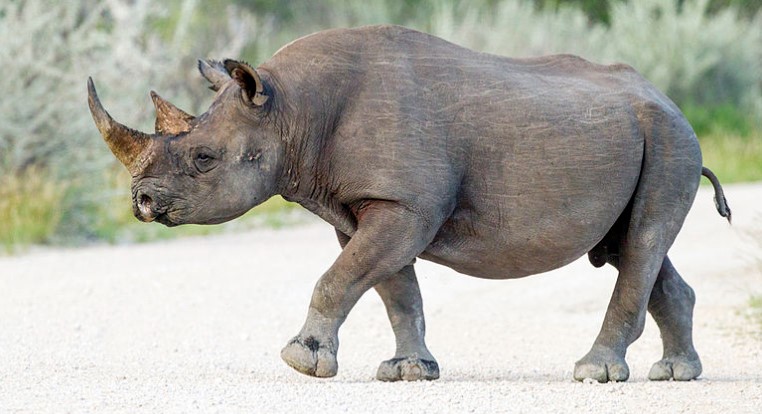
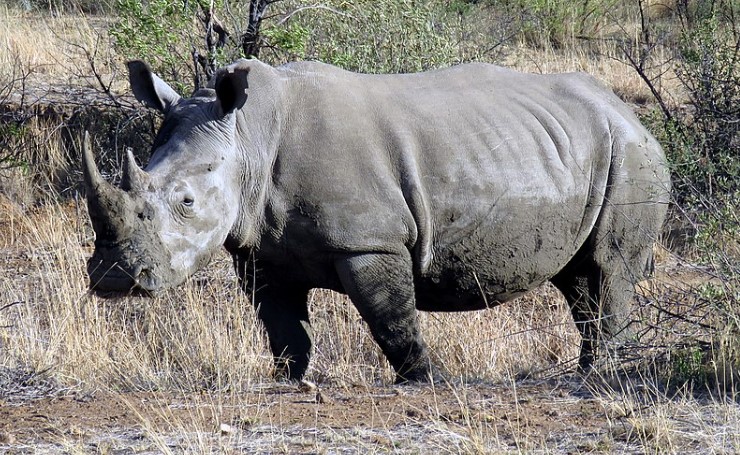
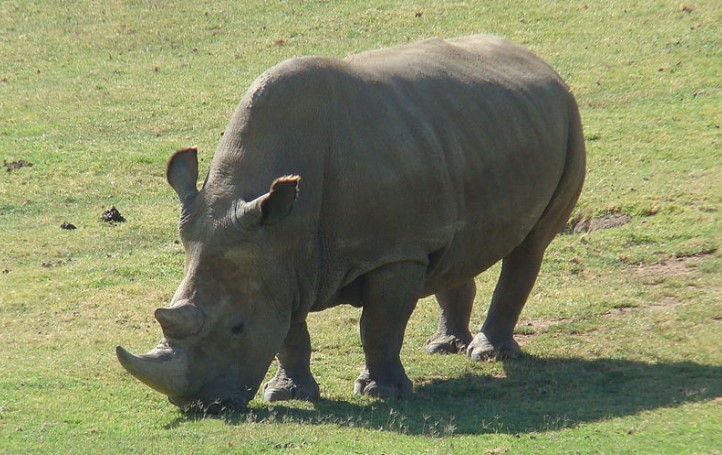
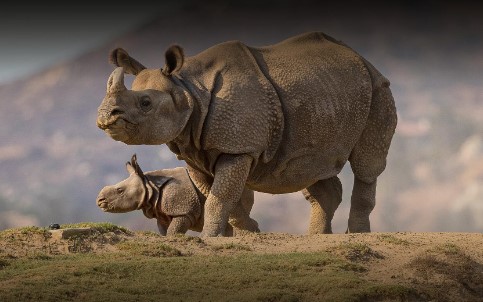
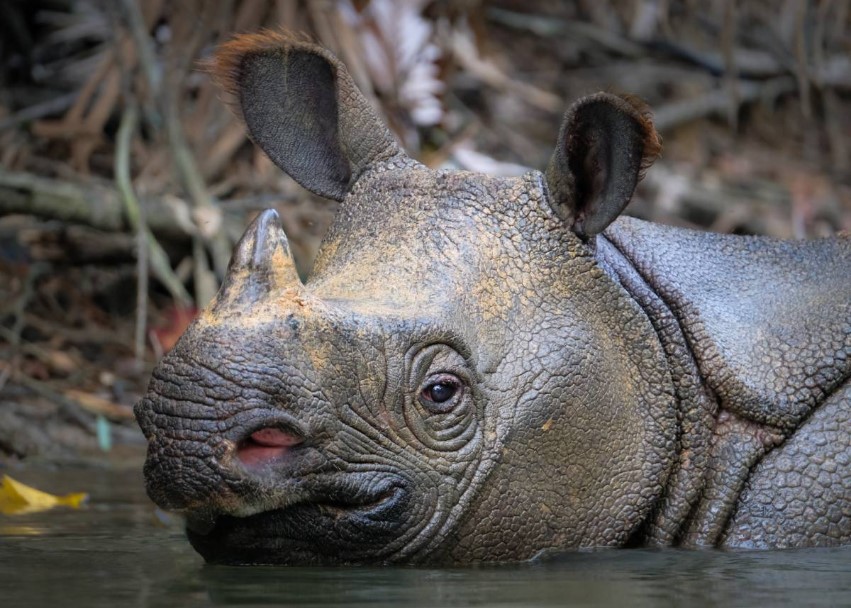
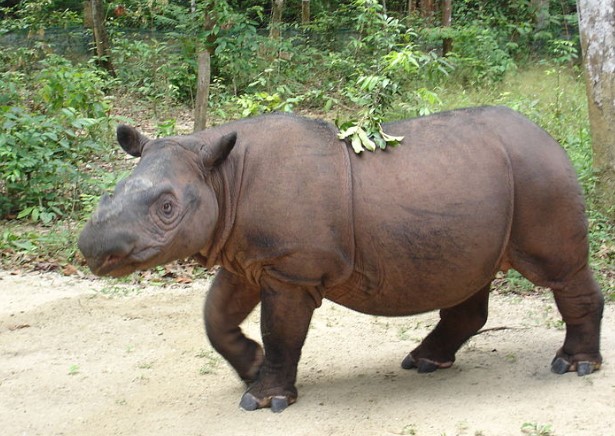






Rhinos are odd-toed ungulates that are native to Africa and Asia. They are found in open grasslands and rainforests. Many species of rhino are critically endangered or endangered. They also have one or two horns depending on the species. There are five species of rhinos. Black rhinos and white rhinos live in Africa. Indian, Javan, and Sumatran rhinos live in Asia.
Rhinos have huge bodies with wrinkled skin and four pillar-like legs. They have one or two horns on their nose and small eyes. They use their horns mostly for fighting and defending themselves or their young. They have very bad eyesight. Although the white and black rhinoceros are thought to have white and black skin, both of these African species are gray.
Rhinos mostly live in groups called crashes. Asian rhinos mostly live solitary lives except when the female has her babies. The males mostly fight one another for females. The gestation period is roughly 15-18 months. Once it ends, they give birth to a single calf. Once the calf grows up, it’s on its own. Adult rhinos have no natural predators (other than humans) due to their size. Calves are mostly preyed on by lions and hyenas.
Rhinos are herbivores and mostly eat different types of plants and grasses. The white rhino is a grazer and uses its square-shaped lip to pluck grasses off the ground. The black rhino is a browser and mostly eats leaves from bushes using its pointed lip. Many African rhinos don’t swim except the black rhino but the Asian rhinos can swim. Some have even been known to dive underwater to eat the plants there.
These rhino species belong to Africa
The black rhinoceros(Diceros bicornis) is an African rhino that is from Southern Africa. It is divided into four subspecies: the South-Central black rhinoceros(Diceros bicornis minor) which is the most numerous of the four, the South-Western black rhinoceros(Diceros bicornis occidentalis) which is better adapted to the arid and semi-arid savannas of Namibia, southern Angola, western Botswana, and western South Africa, East African black rhinoceros (Diceros bicornis michaeli) which lives in Tanzania, and the West African black rhinoceros(Diceros bicornis longipes) which was declared extinct in 2011. Black rhinos are listed as Critically Endangered.
The white rhinoceros (Ceratotherium simum) is an African rhino and the second-largest animal behind the elephant. It is divided into two subspecies: the Southern white rhinoceros(Ceratotherium simum simum) and the Northern White rhinoceros (Ceratotherium simum cottoni). The Southern white rhinoceros has the most range of any rhino and is listed as Near Threatened. The Northern white rhino only has two females at the Ol Pejeta Conservancy in Kenya. Workers there are trying to clone a male rhino so they can have babies and replenish the population. It is listed as Critically Endangered.
These rhino species belong in Asia
The Indian rhinoceros(Rhinoceros unicornis) is an Asian rhino found in mainland Asia. They once ranged throughout the entire stretch of the Indo-Gangetic Plain, but excessive hunting and agricultural development reduced its range drastically to 11 sites in northern India and southern Nepal. 85% of its population is concentrated in Assam where 70% of the population is in Kaziranga National Park. Indian rhinos have thick grey-brown skin with pinkish skin folds and one horn on their snout. Their upper legs and shoulders are covered in wart-like bumps. They have very little body hair, aside from eyelashes, ear fringes, and tail brushes. Bulls have huge neck folds. Horns are present in the males and females but not in the calves. They are grazers whose diet consists of grasses but will also feed on leaves, twigs, flowers, fruits, and many aquatic plants. It’s listed as Vulnerable on the IUCN Red List.
The Javan rhinoceros(Rhinoceros sondaicus) is an Asian rhino and one of the most endangered large mammals in the world. Once the most widespread, the Javan rhino now lives on the island of Java. They are smaller than the Indian rhinoceros and are closer in size to the black rhinoceros. The Javan rhino has a single horn but the bulls only have it while the females don’t. They have hairless, splotchy gray or gray-brown skin which falls in folds to the shoulder, back, and rump. The skin has a natural mosaic pattern, which lends the rhino an armored appearance. The neck folds of Javan rhinos are smaller than those of the Indian rhinoceros, but still, form a saddle shape over the shoulder. They mostly eat diverse plant species, especially their shoots, twigs, young foliage, and fallen fruit. Most of the plants favored by the species grow in sunny areas in forest clearings, shrubland, and other vegetation types with no large trees. The rhino knocks down saplings to reach its food and grabs it with its prehensile upper lip. It is the most adaptable feeder of all the rhino species. It’s listed as Critically Endangered on the IUCN Red List.
The Sumatran rhinoceros(Dicerorhinus sumatrensis) is an Asian rhino that is also the smallest and hairiest species of rhino. Unlike the Indian and Javan rhino, the Sumatran rhino has two horns. They also have wrinkled skin with folds along with reddish-brown hair covering their bodies. This rhino has a patch of long hair around its ears and a thick clump of hair at the end of its tail. Like all rhinos, they have very poor vision. The Sumatran rhinoceros is fast and agile; it climbs mountains easily and comfortably traverses steep slopes and riverbanks. It’s a folivore with a diet of young saplings, leaves, twigs, and shoots. Like the Javan rhino, it’s listed as Critically Endangered.
Rhinos are going endangered around the world. Poaching for their horns is the main reason why they are going extinct. Many people believe that rhino horns have medicinal properties and buy them. In reality, rhino horns are made of keratin and they don’t have medicinal powers at all. Habitat loss is also a major threat.